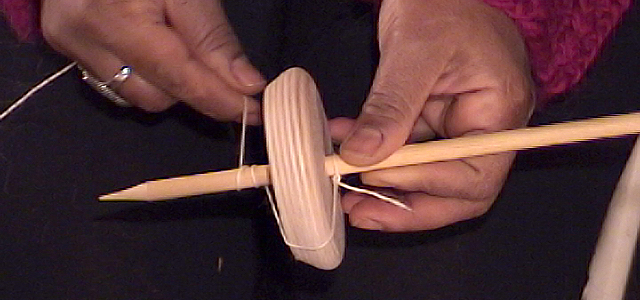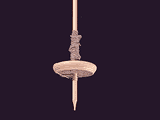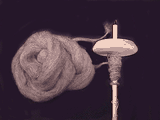For centuries, the handspindle played a role in producing thread and yarn. It is still a tool used in parts of the world today. The form and function of the spindle is basically the same everywhere. It has a very simple design consisting of a shaft and a weight. The materials used to make the spindle in the past consisted of whatever was readily available at the time. The majority of the spindles available today, have wooden shafts with a wooden disc as the whorl (weight). Choosing the type of spindle to use, is determined by the type of yarn you want to produce, and the type of fiber being used. There are basically two types of spindles; suspended and supported.
Bottom / Low Whorl Spindle
This type of spindle is commonly referred to as the drop spindle. It is widely used in Europe and easily found in the United States. The whorl is located at the bottom of the shaft and there is either a hook or a notch at the top of the shaft to catch the yarn. The spun yarn is wound onto the shaft directly above the whorl.
The bottom-whorl spindle is a suspended spindle and is ideal for spinning thicker singles and heavier fibers that require less twist. Spinning fine singles need more twist to keep them together.
The spindle rotates freely suspended from the yarn leaving both hands free to hold and draft the fiber. The spun yarn is released from the hook of the spindle and wound onto the staff directly above the whorl.
Top / High Whorl Spindle
A top-whorl spindle is also a suspended spindle and has the whorl at the top of the shaft and come in a variety of weights. There is a hook on top of the spindle just above the whorl for catching the yarn. Top-whorl spindles can rotate at a higher speed (high-whorl spindle), which makes them ideal for spinning thin yarn and fine fibers. It is believed that the top-whorl spindle originated in the Middle East.
Supported Spindles

Navajo Spindle
The Navajo spindle is an example of a supported spindle. It has a long shaft and a heavy whorl, which makes it too heavy to be spun while being suspended in the air. The spindle has a shaft about 30″ long for use while sitting on the floor, or 33″ long if used from a chair. The whorl is near the bottom of the shaft and is about 4″ in diameter. It is commonly used by the Navajo and Pueblo Indian nations.
The spinner can sit on the floor or in a chair with the bottom part of the shaft resting on the ground and the top part on the thigh. The spindle is rolled up the thigh allowing it to twirl, then sliding it down and rolling it up again, as the yarn twists off the tip of the spindle. After the spun yarn reaches arms length it is wound and stored onto the shaft just above the whorl. Using this spindle on a carpet or sitting it in a small bowl will help to keep it from sliding on the floor.
The one-handed long draw technique is a common way to spin on the Navajo spindle. Therefore, the fiber must be carefully prepared so that the drafting will flow smoothly.





